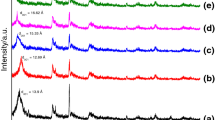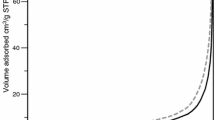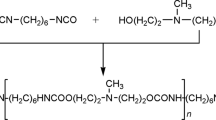Abstract
Research deals with the assessment of grafting of cyclosiloxanes onto organically modified montmorillonite (MMT) layers through anionic ring-opening polymerization (AROP) without additional catalyst or initiator. Pristine Na+-MMT was organically modified by systematically varying the hexadecyltrimethylammonium bromide (HDTMABr) loading level. X-ray diffraction and thermogravimetric analysis of differently modified MMTs (OMMTs) showed that HDTMABr cations that exchanged sodium cations were strongly attracted to the silicate platelet surfaces. Part of HDTMABr formed a sandwiched HDTMABr layer between organically modified silicate platelets. The obtained OMMTs were tested as initiator material for AROP of octamethylcyclotetrasiloxane (D4) in the bulk, since the D4 polymerization may be initiated by oxygen anions located on the silicate surfaces. The highest monomer conversion (91 % after 24 h at 80 °C) was observed when OMMT with HDTMABr amount equal to cation exchange capacity was used. At lower amounts of HDTMABr, the MMT was less organically modified and thus less compatible with D4. On the other hand, when the HDTMABr sandwiched layer was thicker, lower rates of polymerization were observed due to the hindered transport of monomer to silicate platelet surfaces. The active function of surface anions in MMT platelets in the initiation process was confirmed experimentally by varying the OMMT/D4 ratio. It was observed that monomer conversion increased with increasing OMMT/D4 ratio. The obtained composites were exfoliated. In the last part of the research, OMMT was added to the formulation for D4 emulsion polymerization, where HDTMABr was also used as an emulsifier. The obtained composite material had a significantly improved thermal stability.







Similar content being viewed by others
References
Schmidt DF, Giannelis EP (2009) Silicate dispersion and mechanical reinforcement in polysiloxane/layered silicate nanocomposites. Chem Mater 22:167–174. doi:10.1021/cm9026978
Schmidt DF, Clément F, Giannelis EP (2006) On the origins of silicate dispersion in polysiloxane/layered-silicate nanocomposites. Adv Funct Mater 16:417–425. doi:10.1002/adfm.200500008
Fukushima Y, Inagaki S (1987) Synthesis of an intercalated compound of montmorillonite and 6-polyamide. J Incl Phenom 5:473–482. doi:10.1007/BF00664105
Usuki A, Kojima Y, Kawasumi M, Okada A, Fukushima Y, Kurauchi T, Kamigaito O (1993) Synthesis of nylon 6-clay hybrid. J Mater Res 8:1179–1184. doi:10.1557/JMR.1993.1179
LeBaron PC, Wang Z, Pinnavaia TJ (1999) Polymer-layered silicate nanocomposites: an overview. Appl Clay Sci 15:11–29. doi:10.1016/S0169-1317(99)00017-4
Alexandre M, Dubois P (2000) Polymer-layered silicate nanocomposites: preparation, properties and uses of a new class of materials. Mat Sci Eng R 28:1–63. doi:10.1016/S0927-796X(00)00012-7
Okamoto M (2006) Recent advances in polymer/layered silicate nanocomposites: an overview from science to technology. Mater Sci Technol 22:756–779. doi:10.1179/174328406x101319
Sinha Ray S, Okamoto M (2003) Polymer/layered silicate nanocomposites: a review from preparation to processing. Prog Polym Sci 28:1539–1641. doi:10.1016/j.progpolymsci.2003.08.002
Giannelis EP (1996) Polymer layered silicate nanocomposites. Adv Mater 8:29–35. doi:10.1002/adma.19960080104
Tasdelen MA, Kreutzer J, Yagci Y (2010) In situ synthesis of polymer/clay nanocomposites by living and controlled/living polymerization. Macromol Chem Phys 211:279–285. doi:10.1002/macp.200900590
Lewicki JP, Liggat JJ, Patel M (2009) The thermal degradation behaviour of polydimethylsiloxane/montmorillonite nanocomposites. Polym Degrad Stab 94:1548–1557. doi:10.1016/j.polymdegradstab.2009.04.030
Nishihama S, Yamada H, Nakazawa H (1997) Polymerization of tetramethylcyclotetrasiloxane monomer by ion-exchanged montmorillonite catalysts. Clay Min 32:645–651. doi:10.1180/claymin.1997.032.4.14
Ma J, Xu J, Ren J-H, Yu Z-Z, Mai Y-W (2003) A new approach to polymer/montmorillonite nanocomposites. Polymer 44:4619–4624. doi:10.1016/S0032-3861(03)00362-8
Bruzaud S, Levesque G (2002) Polysiloxane-g-TiNbO5 nanocomposites: synthesis via in situ intercalative polymerization and preliminary characterization. Chem Mater 14:2421–2426. doi:10.1021/cm021108b
Beigbeder A, Bruzaud S, Mederic P, Aubry T, Grohens Y (2005) Rheological characterization of polydimethylsiloxane/HTiNbO5 nanocomposites prepared by different routes. Polymer 46:12279–12286. doi:10.1016/j.polymer.2005.10.086
Lebrun L, Bruzaud S, Grohens Y, Langevin D (2006) Elaboration and characterisation of PDMS-HTiNbO5 nanocomposite membranes. Eur Polym J 42:1975–1985. doi:10.1016/j.eurpolymj.2006.03.016
Messersmith PB, Giannelis EP (1993) Polymer-layered silicate nanocomposites: in situ intercalative polymerization of ε-caprolactone in layered silicates. Chem Mater 5:1064–1066. doi:10.1021/cm00032a005
Messersmith PB, Giannelis EP (1995) Synthesis and barrier properties of poly(ε-caprolactone)-layered silicate nanocomposites. J Polym Sci Part A Polym Chem 33:1047–1057. doi:10.1002/pola.1995.080330707
Lepoittevin B, Pantoustier N, Alexandre M, Calberg C, Jerome R, Dubois P (2002) Polyester layered silicate nanohybrids by controlled grafting polymerization. J Mater Chem 12:3528–3532. doi:10.1039/B205787E
Viville P, Lazzaroni R, Pollet E, Alexandre M, Dubois P (2004) Controlled polymer grafting on single clay nanoplatelets. J Am Chem Soc 126:9007–9012. doi:10.1021/ja048657y
Pantoustier N, Lepoittevin B, Alexandre M, Dubois P, Kubies D, Calberg C, Jérôme R (2002) Biodegradable polyester layered silicate nanocomposites based on poly(ε-caprolactone). Polym Eng Sci 42:1928–1937. doi:10.1002/pen.11085
Lepoittevin B, Pantoustier N, Devalckenaere M, Alexandre M, Calberg C, Jerome R, Henrist C, Rulmont A, Dubois P (2003) Polymer/layered silicate nanocomposites by combined intercalative polymerization and melt intercalation: a masterbatch process. Polymer 44:2033–2040. doi:10.1016/s0032-3861(03)00076-4
Lepoittevin B, Pantoustier N, Devalckenaere M, Alexandre M, Kubies D, Calberg C, Jerome R, Dubois P (2002) Poly(ε-caprolactone)/clay nanocomposites by in situ intercalative polymerization catalyzed by dibutyltin dimethoxide. Macromolecules 35:8385–8390. doi:10.1021/ma020300w
Liao LQ, Zhang C, Gong SQ (2007) Preparation of poly(ε-caprolactone)/clay nanocomposites by microwave-assisted in situ ring-opening polymerization. Macromol Rapid Commun 28:1148–1154. doi:10.1002/marc.200700063
Tarkin-Tas E, Goswami SK, Nayak BR, Mathias LJ (2008) Highly exfoliated poly(ε-caprolactone)/organomontmorillonite nanocomposites prepared by in situ polymerization. J Appl Polym Sci 107:976–984. doi:10.1002/app.26964
Ganachaud F, Boileau S (2009) Siloxane-containing polymers. In: Dubois P, Coulembier O, Raquez JM (eds) Handbook of ring-opening polymerization. Wiley-VCH GmbH & Co, KGaA, Germany
Jones RG, Ando W, Chojnowski J (2001) Silicon-containing polymers: the science and technology of their synthesis and applications. Springer, The Netherlands
Mohorič I, Šebenik U (2011) Anionic ring-opening polymerization of octamethylcyclotetrasiloxane in emulsion above critical micelle concentration. Polymer 52:1234–1240. doi:10.1016/j.polymer.2011.01.025
Zhao Z, Tang T, Qin Y, Huang B (2003) Relationship between the continually expanded interlayer distance of layered silicates and excess intercalation of cationic surfactants. Langmuir 19:9260–9265. doi:10.1021/la030056h
LaRochelle RW, Cargioli JD, Williams EA (1976) Viscosity-molecular weight correlations of disiloxanols by 29Si Fourier transform nuclear magnetic resonance. Macromolecules 9:85–88. doi:10.1021/ma60049a016
Lewis RN (1948) Methylphenylpolysiloxanes. J Am Chem Soc 70:1115–1117. doi:10.1021/ja01183a073
Grassie N, Macfarlane IG (1978) Thermal degradation of polysiloxanes.1. Poly(dimethylsiloxane). Eur Polym J 14:875–884. doi:10.1016/0014-3057(78)90084-8
Thomas TH, Kendrick TC (1969) Thermal analysis of polydimethylsiloxanes. I. Thermal degradation in controlled atmospheres. J Polymer Sci 2 Polymer Phys 7:537. doi:10.1002/pol.1969.160070308
Lewis CW (1959) The pyrolysis of dimethylpolysiloxanes. II. J Polym Sci 37:425–429. doi:10.1002/pol.1959.1203713212
Camino G, Lomakin SM, Lazzari M (2001) Polydimethylsiloxane thermal degradation—Part 1. Kinetic aspects. Polymer 42:2395–2402. doi:10.1016/s0032-3861(00)00652-2
Camino G, Lomakin SM, Lageard M (2002) Thermal polydimethylsiloxane degradation. Part 2. The degradation mechanisms. Polymer 43:2011–2015. doi:10.1016/s0032-3861(01)00785-6
Mohorič I, Krajnc M, Šebenik U (2009) Model-free kinetics analysis of thermal degradation of polysiloxane lubricant. Chem Biochem Eng Q 23:493–496
Mohorič I, Šebenik U (2011) Semibatch anionic ring-opening polymerization of octamethylcyclotetrasiloxane in emulsion. Polymer 52:4423–4428. doi:10.1016/j.polymer.2011.07.045
Mohorič I, Šebenik U (2013) Semibatch anionic ring-opening polymerization of octamethylcyclotetrasiloxane in emulsions: effect of the amount of seed polymer particles. Polym Int 62:1022–1028. doi:10.1002/pi.4386
Acknowledgments
The financial support of this work by the Slovenian Ministry of Higher Education, Science and Technology (Grant P2-0191) is gratefully acknowledged. The authors would like to express their gratitude to Dr. Ines Mohorič for the TGA analysis.
Author information
Authors and Affiliations
Corresponding author
Rights and permissions
About this article
Cite this article
Ručigaj, A., Krajnc, M. & Šebenik, U. Polymerization of octamethylcyclotetrasiloxane between montmorillonite nanoplatelets initiated by surface anions. Polym. Bull. 72, 1863–1878 (2015). https://doi.org/10.1007/s00289-015-1377-5
Received:
Revised:
Accepted:
Published:
Issue Date:
DOI: https://doi.org/10.1007/s00289-015-1377-5




